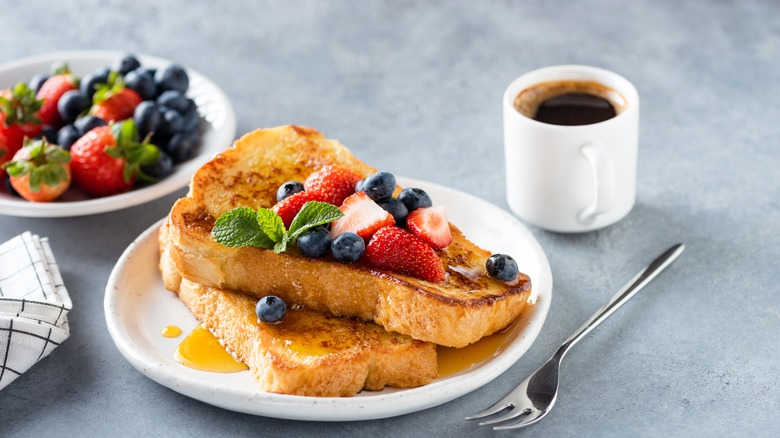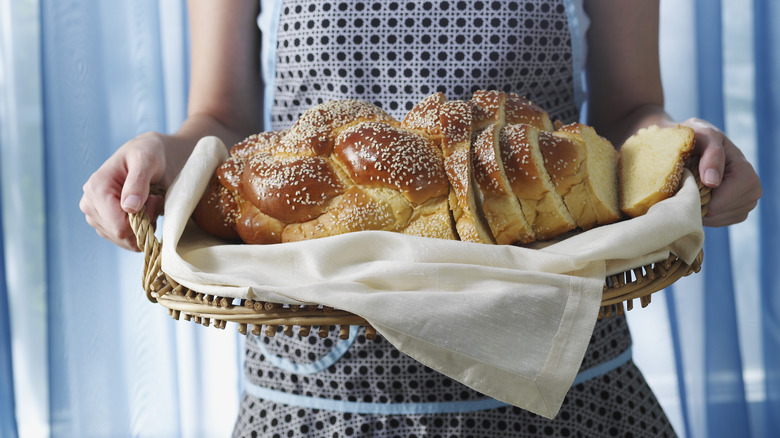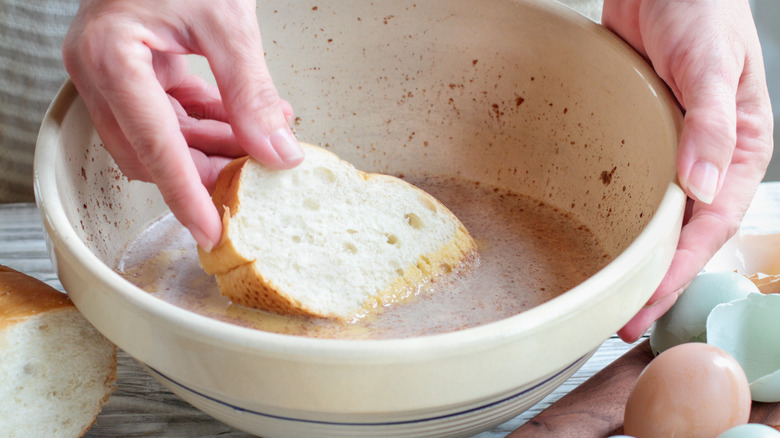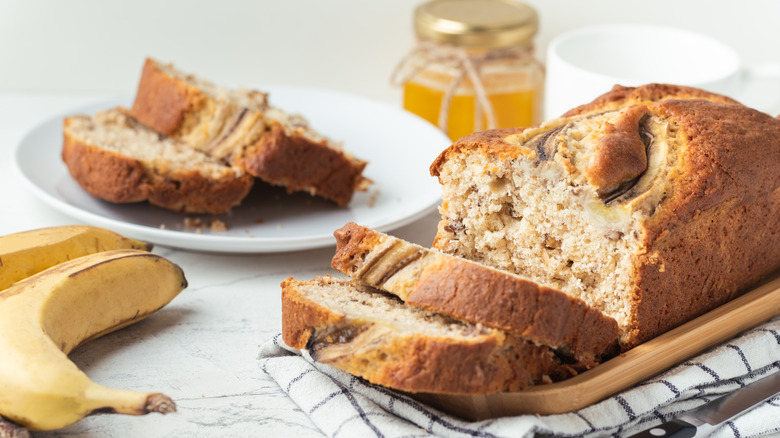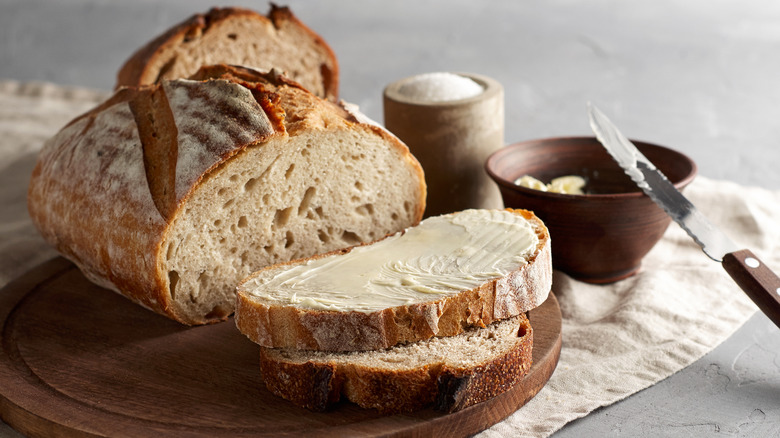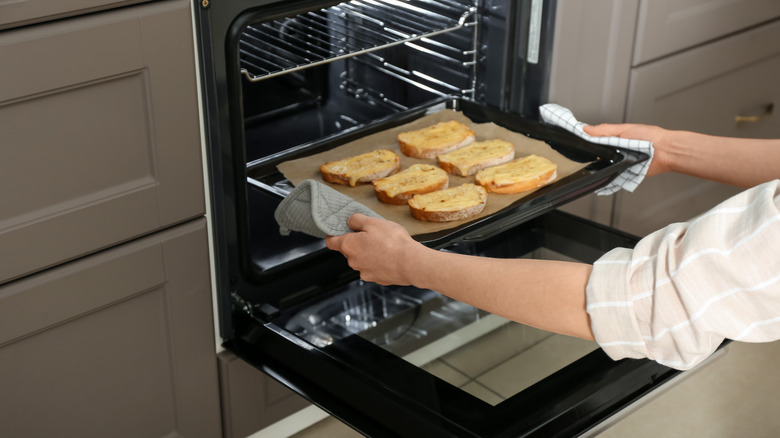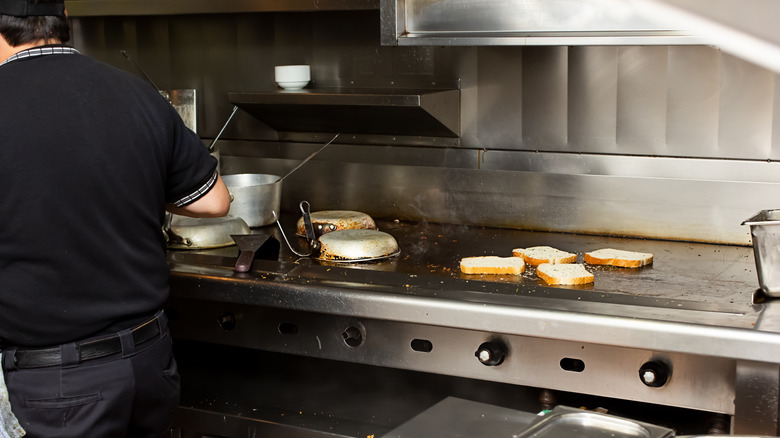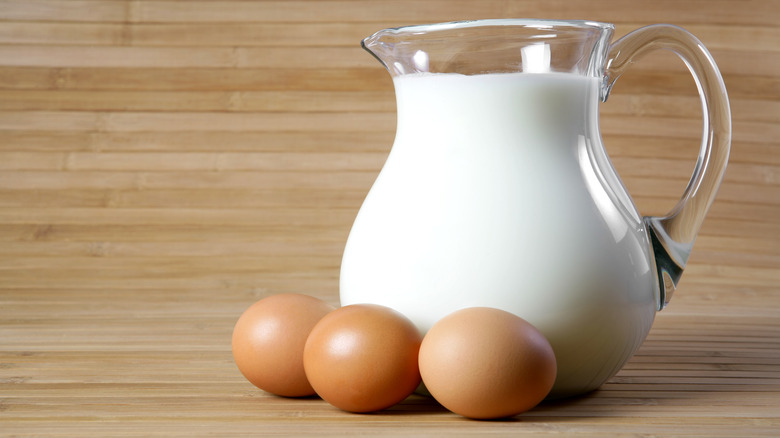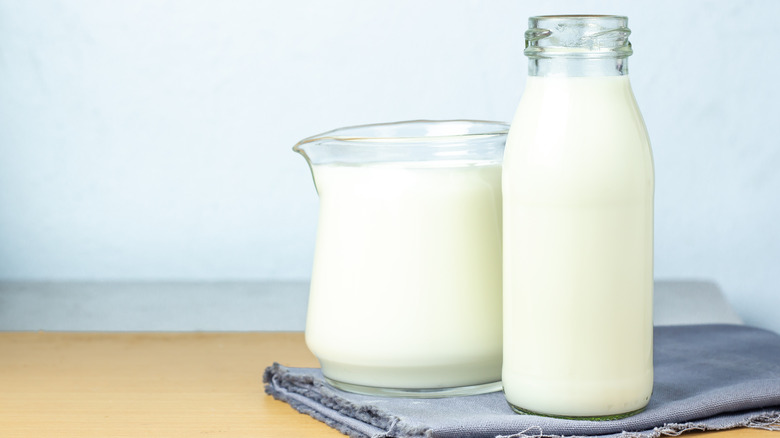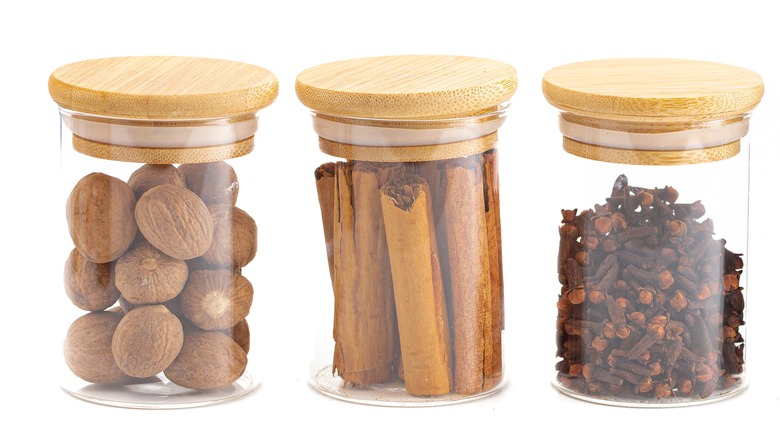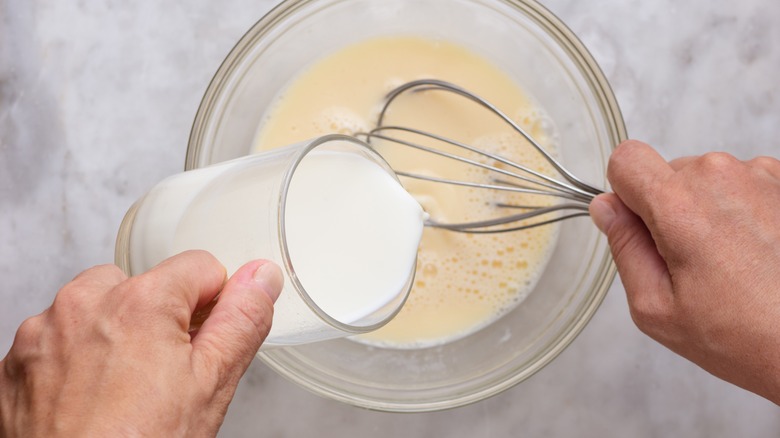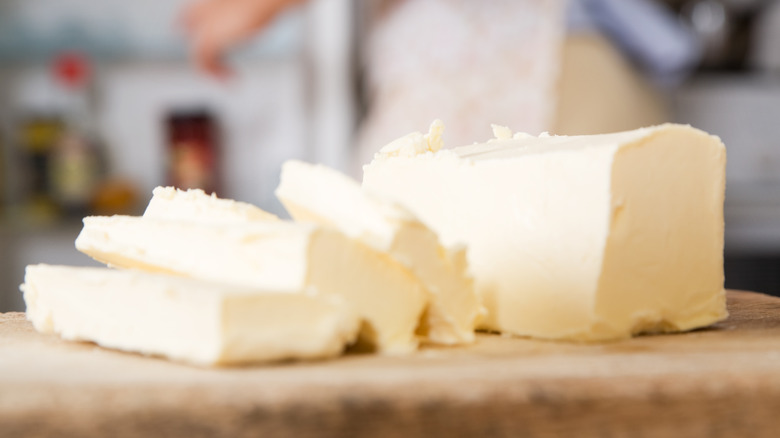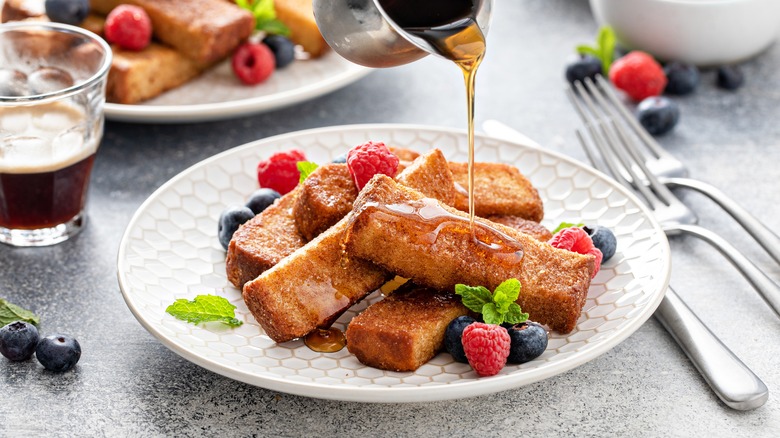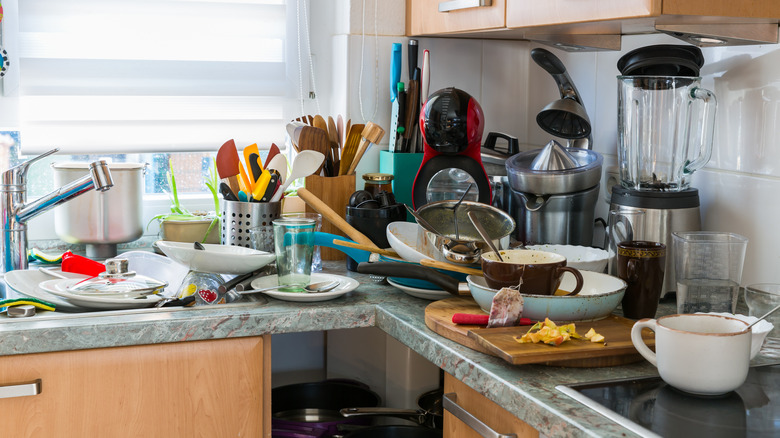Why French Toast Always Tastes Better At A Restaurant
French toast is a food with many names. While we give it the moniker "French," the French meanwhile call it "pain perdu," which means "lost bread." Other names include eggy bread and nun's toast. Whatever name it goes by, French toast is, at its core, a basic recipe consisting of old bread and a custard typically made of egg and milk. Versions of the dish go back to the ancient Romans. French toast was invented as a way to use up stale bread. It is as practical and economical as it is delicious.
Despite being relatively simple and easy to make, French toast always seems like it tastes better when it comes from a restaurant. Restaurants are at the top of the game when it comes to perfecting dishes, but even cheap diners and fast food restaurants know the secret to French toast. We searched high and low to discover why French toast always tastes better at restaurants.
They do not use grocery store bread
Grocery store bread has a time and a place, but it is not in French toast. When restaurants make French toast, they use bread that is very different from the thinly sliced sandwich loaves found throughout the bread aisle of your local grocery.
There are a few reasons forgoing typical grocery store bread makes all the difference in the outcome of French toast. First, pre-sliced grocery store bread means you get thin wispy little pieces of bread. This is great for packing lunch but not ideal for a hearty slab of French toast perfection. Sometimes the greatest thing is not sliced bread.
Second, grocery store bread is often pumped full of preservatives to keep it soft and fresh. Which, again, is excellent for sandwiches, but it is counter-productive for French toast, a dish specifically designed around stale bread.
Take a look at any of your favorite restaurant's French toasts. You will likely find thick Texas-cut slices of bread. They may even make them with enriched bread, such as brioche or challah, cut into substantial hunks. This sets restaurant French toast apart from sad flimsy French toast made from Wonder Bread and the like.
Restaurants let it sit
The key to many facets of cooking is time. The same is true for French toast. While at home, it is easy to haphazardly dunk bread into the egg and milk wash and call it a day; restaurants know the key to good French toast is to let it sit.
For pan-fried French toast, this means letting the slices of thick bread really absorb the liquid. It can take up to five minutes of soaking for the bread to really absorb all the liquid it needs. The bread needs this much time because, as discussed, it is often thicker than sliced grocery store bread, and the wash requires time to permeate throughout
Of course, French toast comes in various forms — both at home and in restaurants. If you wondered why baked French toast at restaurants is so custardy and delicious, it is because they do not just pour and bake. A few minutes simply will not cut it. Restaurants may let the bread sit in the egg and milk wash overnight, allowing a thorough saturation before cooking.
They ignore traditional bread altogether
Sometimes though, the reason restaurant French toast is so much better is that they think outside of the box, or bag as the case may be, and forgo traditional bread altogether. Restaurants are experts at getting creative with ingredients to create delicious new takes on classic dishes.
The Dor-Stop, for example, has been known to use banana bread as the basis for its French toast. This is a creative way to use up a surplus of banana bread, resulting in an ultra-decadent French toast.
Other restaurants, such as Pamela's Diner, use croissants as a base for one of its French toast offerings. This adds flakey laminated pastry to an already decadent, delectable treat. It would be hard to beat something like that at home using regular old bread.
Other options include using cinnamon raisin bread, leftover babka, or even pound cake. Restaurants are masters at using ingredients they have on hand to create dishes. To reduce waste and replicate this at home, find a tasty bready treat you have left over and turn it into French toast. At last, there is a use for all those croissants that come in a pack from Costco.
Restaurants are not using fresh bread
A final note on bread choices: restaurants are not using fresh bread. And why would they? Fresh bread means more upfront cost, and when it comes to French toast, fresh bread actually produces a lower-quality product.
French toast was designed as a way to use up stale bread. Its whole purpose in life is to prevent food waste in a delicious way. Stale, dry bread does a better job of soaking up the milk and egg mixture than fresh bread.
If restaurants use fresh bread, they often dry it out before turning it into French toast. This can mean simply opening up some bread, exposing it to the air, and letting it get stale naturally, or putting sliced pieces in an oven to dry it out. Either way, restaurants are not using fresh, soft fluffy bread for their French toast. They reserve that for sandwiches. Once it has passed that stage, it is time for a bath in some egg wash and some frying.
It is double cooked
Have you ever noticed that when you make French toast at home, it gets soggy and limp when it is time to serve, yet when you order French toast at a restaurant, it is perfectly crispy on the outside? Yet no matter how hard you try and how well you fry your French toast initially, it never ends up that perfectly balanced. There is a reason for that. Restaurants are not just cooking French toast and leaving it on a plate to gather moisture from steam while the chef fries up the next batch. They use tricks to keep the French toast warm and from collecting extra moisture.
Chef Alton Brown uses a method where you layer an oven-safe cooling rack on top of a baking sheet. Once each batch of French toast is done cooking, place them in a single layer on the baking sheet, and put that into the oven. This will keep all the French toast warm and crispy. The oven should be set low enough that even though they are warm, it is not going to burn the French toast. Restaurants really go all out for that food experience.
They use the right cooking equipment
Having the right implements is half the battle when it comes to cooking. Restaurants have the right equipment when it comes to cooking French toast, and they know how to use them. Two main options for cooking stove-top French toast are a griddle or a frying pan.
Most restaurants, especially diner-style restaurants, have a griddle. Griddles are large, heated flat tops. Instead of cooking in a pan, you cook right on the griddle. Griddles are perfect for cooking breakfast food because they cook quickly and hot. This makes them ideal for French toast. It gives a nice crispy outside without overcooking the inside. Home cooks can replicate this by using a plug-in electric griddle if one is available.
Of course, not all restaurants cook French toast on a griddle. However, those doing it in a pan know how to do it correctly. First, the pan must be hot before food is added; otherwise, the food will stick, and you will lose that delicious crispy outside. Next, the butter or oil must also be hot before adding the dredged bread. You want that quintessential sizzle the minute the bread hits the pan. That sound isn't just pleasing to the ear; it lets you know the bread is cooking and crispy cooked French toast is on its way.
They have the milk-to-egg ratio down
Restaurants know there is a particular technique when it comes to the mixture you use to soak the bread for French toast. They have had plenty of time to figure out the ideal milk-to-egg ratio for the custard base.
Some of it comes down to preference, as some chefs prefer a milk-heavy base, and some prefer an egg-heavy base. However, if you find that your French toast just never matches up to that at a restaurant, you might have the wrong ratio.
An egg-heavy French toast batter will produce a thicker, fattier French toast. Since there is not as much liquid, the result will be heavier and more dense. French toast that is milk heavy will be lighter. While there is no right or wrong answer, milk-heavy French toast can potentially produce a soggy product. Putting bread in too much milk can cause it to start to disintegrate. Restaurants know which kind of French toast they make and how to handle it.
They use high-fat dairy
As discussed, too much liquid can cause French toast to break apart and be a soggy mess, which nobody wants. Restaurants have a way of working around that, though. They will avoid low-fat or skim milk in favor of high-fat dairy options.
The high-fat dairy will give a luscious creamy taste and texture because it has more cream. Whole-fat milk is a good standard. It will add moisture but has enough fat to add that rich texture for perfect custardy French toast. But why stop there? Restaurants go beyond just using whole-fat milk. Alton Brown uses half and half, which is half whole milk and half heavy cream. Some restaurants, such as Crest Cafe, forgo the milk part in favor of straight-up heavy cream.
It is easy to see why restaurant French toast is so good when they use thicker dairy products to make French toast. Home cooks, meanwhile, are less likely to have heavy cream or half-and-half hanging about in the kitchen. However, all is not lost for homemade French toast. While for many years, low-fat milk sales were on an upward trend, now low-fat milk sales are going down, and whole milk sales are on the rebound. This means the trend could help bring better French toast to kitchens everywhere.
Restaurants go beyond eggs and milk
The home cook's simple and basic way to make French toast is just two ingredients, eggs and milk. That is fine and all, but it will not win any awards. Restaurants excel because they know how to add little ingredients that make a big difference. Spices like cinnamon, nutmeg, or ginger can be added to round out the flavor and add a spiced note to the French toast. A splash of vanilla in the batter brightens the flavor and enhances the natural sweetness of the batter.
Even something as little as a pinch of salt can make all the difference. Salt acts as a flavor enhancer. It can balance out foods that tend on the sweet side, such as French toast. Restaurants know that adding salt does not make something salty but simply better. Similarly, honey and sugar are common additions to the custard base, adding even more sweetness.
Of course, though, restaurant French toast does not stop with how they make the custard. Once the French toast is made, they will stuff and top it with all sorts of goodies: sliced fruit, caramel sauce, whipped cream, and custard. The list goes on. Plain homemade French toast simply can't compete with such grandeur.
They know the importance of blending
Blending isn't just a vital makeup technique but is also crucial to making French toast. While both eggs and milk are considered liquids, eggs have a bit more subsistence to them. Anyone who makes French toast knows that without intervention, the egg and the milk will not become one. However, simply giving the egg a little mix is not enough.
Restaurants such as Crest Cafe add pre-beaten eggs to their mixture. This helps ensure the eggs and the yolks have already come together. Then the liquid and the eggs are whisked together. A homogeneous custard is formed, which evenly coats and soaks into the bread for French toast. Without proper blending, the French toast ends up with patches of scrambled egg instead of custard.
Some restaurants will even go above and beyond and strain the custard base for an ultra-silky finish with no patches of egg. Sure, this uses more dishes, but it is worth it for restaurant-quality French toast.
When in doubt, add butter
While at home, it is tempting just to use a little spray oil or a small patch of butter; restaurants have no such compunction. They are working off the Julia Child approach, which uses generous quantities of butter.
Butter can be added at almost any point in the cooking process, making a huge difference in taste. Butter adds fat and often salt, making the whole dish fatty, crispy, and delectable. You may wonder if just the butter is enough to make such a difference, and the answer is yes. Take it from Anthony Bourdain. As he expressed to Oprah, restaurants use a staggering amount of butter in each dish, and they use it throughout the cooking process. It makes the food nearly irresistible.
Restaurants will fry the French toast in butter, which adds a lovely browned butter flavor to the overall dish, which you simply do not get from oil alone. Some go a step further. Denny's French toast, for example, is even served with butter on top.
They deep fry French toast sticks
We all know that everything tastes better deep-fried. The same holds true for French toast. Restaurant French toast does not have to be fancy to be tasty. If you have ever wondered why those cheap fast food french toast sticks are so freaking delicious, it is because they are deep fried.
Fast food restaurants such as Wendy's and Burger King deep fry the French Toast sticks to create French toast that is better than the stuff made at home. If you are looking for a similarly crispy stick at home, it will be time to heat a high-walled pan of oil or invest in a deep fryer.
However, if you want to mimic this restaurant goodness, you can try finishing your French toast sticks in an air fryer or convection oven on a rack so that air can circulate around it and crisp all sides. This will help add that restaurant quality to even the cheapest box of grocery-store French toast sticks. Just make sure not to put anything actively dripping in the air fryer unless you want a big cleanup.
They play to tastes with salt, sugar, and fat
Restaurants know how to play to our taste buds. We have already discussed how many restaurants add more salt, sugar, and fat to food to make their food taste better, but that does not do justice to the instinctive drive humans have toward these foods. In his book "Salt Sugar Fat" Michael Moss looks at the food industry and how food is specifically designed to appeal to those three tastes. In an interview with CNN, Moss discusses the idea of the "bliss point," which is the amount of something that will make humans hooked on the food.
Moss found that the three components — salt, sugar, and fat — were higher in many prepared foods. Take IHOP, for example. IHOP's Original French Toast contains 27 grams of fat, 570 of sodium, and 19 grams of sugar. This is significantly more than homemade, which can fluctuate, but a single slice can be as low as 3.36 grams of fat, 150 grams of sodium, and 1 gram of sugar. When you compare the two, it is easy to see why a restaurant's French toast tastes better. It is simply playing with brain chemistry.
You didn't have to make it
When you get French toast at a restaurant, you are not just getting French toast. You are getting eggs, bacon, sausage, and maybe some fresh fruit. The point is you are getting a whole multicourse meal. It is hard to top that at home with just some French toast and basic fixings like syrup or powdered sugar. Of course, you can add these other things, but that means more work and more dishes.
Often, food just tastes better when you are not the one to cook it. There are no dishes to do or work to put in; you are simply presented with food. Additionally, a study from Yale showed that eating food in the presence of another person also eating that food led to increased enjoyment. The quality of the food does not change, but simply being in a restaurant with other people enjoying the same food can be enough to make French toast taste better.
